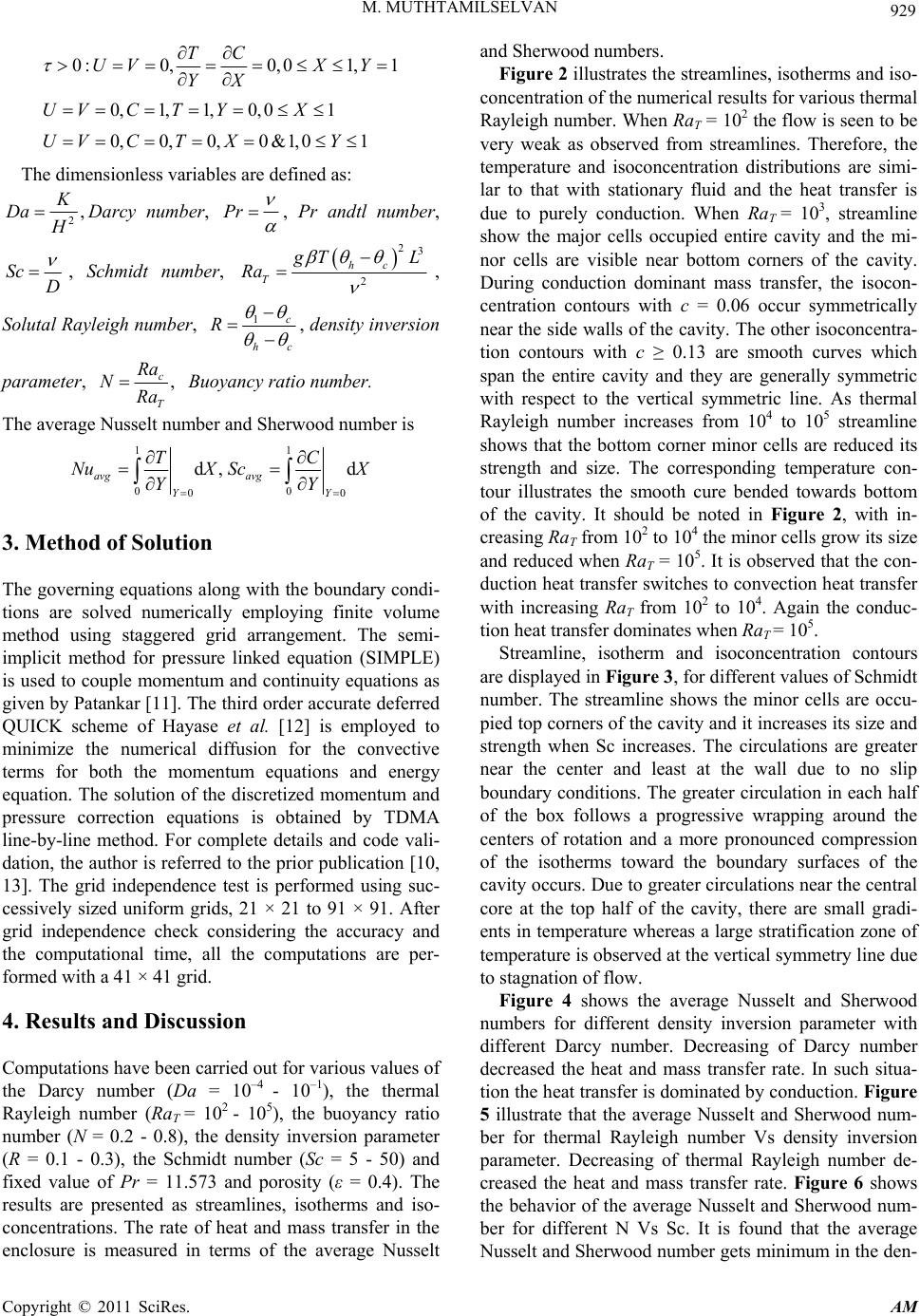
M. MUTHTAMILSELVAN
929
0:0,0,01, 1
TC
UVX Y
YX
0,1,1,0, 01UVC TYX
0,0,0,0&1, 01UVC TXY
The dimensionless variables are defined as:
2,
Da
Darcy number, Pr
, Pr andtl number,
Sc D
, Schmidt number,
23
2
hc
T
T
Ra
L
,
Solutal Rayleigh number, 1c
hc
R
, density inversion
parameter, ,
c
T
Ra
NRa
Buoyancy ratio number.
The average Nusselt number and Sherwood number is
11
00
0
d, d
avg avg
YY
TC
NuX ScX
YY
0
3. Method of Solution
The governing equations along with the boundary condi-
tions are solved numerically employing finite volume
method using staggered grid arrangement. The semi-
implicit method for pressure linked equation (SIMPLE)
is used to couple momentum and continuity equations as
given by Patankar [11]. The third order accurate deferred
QUICK scheme of Hayase et al. [12] is employed to
minimize the numerical diffusion for the convective
terms for both the momentum equations and energy
equation. The solution of the discretized momentum and
pressure correction equations is obtained by TDMA
line-by-line method. For complete details and code vali-
dation, the author is referred to the prior publication [10,
13]. The grid independence test is performed using suc-
cessively sized uniform grids, 21 × 21 to 91 × 91. After
grid independence check considering the accuracy and
the computational time, all the computations are per-
formed with a 41 × 41 grid.
4. Results and Discussion
Computations have been carried out for various values of
the Darcy number (Da = 10–4 - 10–1), the thermal
Rayleigh number (RaT = 102 - 105), the buoyancy ratio
number (N = 0.2 - 0.8), the density inversion parameter
(R = 0.1 - 0.3), the Schmidt number (Sc = 5 - 50) and
fixed value of Pr = 11.573 and porosity (ε = 0.4). The
results are presented as streamlines, isotherms and iso-
concentrations. The rate of heat and mass transfer in the
enclosure is measured in terms of the average Nusselt
and Sherwood numbers.
Figure 2 illustrates the streamlines, isotherms and iso-
concentration of the numerical results for various thermal
Rayleigh number. When RaT = 102 the flow is seen to be
very weak as observed from streamlines. Therefore, the
temperature and isoconcentration distributions are simi-
lar to that with stationary fluid and the heat transfer is
due to purely conduction. When RaT = 103, streamline
show the major cells occupied entire cavity and the mi-
nor cells are visible near bottom corners of the cavity.
During conduction dominant mass transfer, the isocon-
centration contours with c = 0.06 occur symmetrically
near the side walls of the cavity. The other isoconcentra-
tion contours with c ≥ 0.13 are smooth curves which
span the entire cavity and they are generally symmetric
with respect to the vertical symmetric line. As thermal
Rayleigh number increases from 104 to 105 streamline
shows that the bottom corner minor cells are reduced its
strength and size. The corresponding temperature con-
tour illustrates the smooth cure bended towards bottom
of the cavity. It should be noted in Figure 2, with in-
creasing RaT from 102 to 104 the minor cells grow its size
and reduced when RaT = 105. It is observed that the con-
duction heat transfer switches to convection heat transfer
with increasing RaT from 102 to 104. Again the conduc-
tion heat transfer dominates when RaT = 105.
Streamline, isotherm and isoconcentration contours
are displayed in Figure 3, for different values of Schmidt
number. The streamline shows the minor cells are occu-
pied top corners of the cavity and it increases its size and
strength when Sc increases. The circulations are greater
near the center and least at the wall due to no slip
boundary conditions. The greater circulation in each half
of the box follows a progressive wrapping around the
centers of rotation and a more pronounced compression
of the isotherms toward the boundary surfaces of the
cavity occurs. Due to greater circulations near the central
core at the top half of the cavity, there are small gradi-
ents in temperature whereas a large stratification zone of
temperature is observed at the vertical symmetry line due
to stagnation of flow.
Figure 4 shows the average Nusselt and Sherwood
numbers for different density inversion parameter with
different Darcy number. Decreasing of Darcy number
decreased the heat and mass transfer rate. In such situa-
tion the heat transfer is dominated by conduction. Figure
5 illustrate that the average Nusselt and Sherwood num-
ber for thermal Rayleigh number Vs density inversion
parameter. Decreasing of thermal Rayleigh number de-
creased the heat and mass transfer rate. Figure 6 shows
the behavior of the average Nusselt and Sherwood num-
ber for different N Vs Sc. It is found that the average
Nusselt and Sherwood number gets minimum in the den-
Copyright © 2011 SciRes. AM